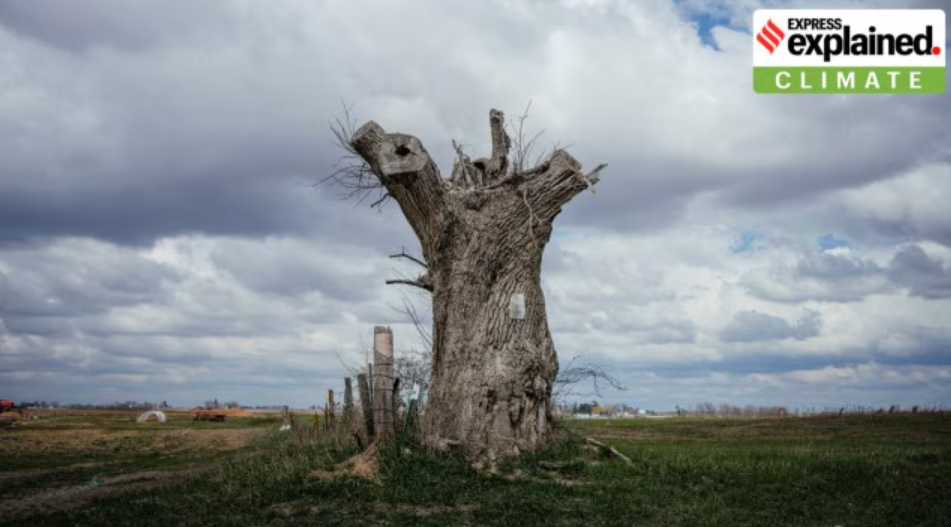Biodiversity loss, which refers to the loss of plant or animal species at a local or worldwide scale, has the biggest impact, according to the study. It was followed by climate change and introduction of non-native species.

As human activities continue to degrade the planet, the risk of infectious disease outbreaks is increasingly becoming more likely. Four human-induced global changes — biodiversity loss, introduction of non-native species, climate change, and chemical pollution — are the leading drivers of disease spread not just among humans but also plants and animals, according to a new study.
The research, ‘A meta-analysis on global change drivers and the risk of infectious disease’, published in the journal Nature earlier this month, has been carried out by a team of 20 researchers from US-based universities such as the University of Notre Dame, Yale University, Oregon State University, and the University of Connecticut.
Previous studies have also highlighted the link between disease spread and environmental changes but their approach was much more targeted. For example, a 2023 study found that warmer temperatures could be leading to a wider spread of malaria in Africa. The latest study has found that these changes are influencing infectious disease risk across the world and species.
What are the findings of the study?
Although the spread of diseases can be influenced by a variety of factors, the researchers focused on five key global change drivers — biodiversity loss, climate change, chemical pollution, non-native species, and habitat loss. They then compiled data from nearly 1,000 previous studies and looked at how these drivers influenced infectious disease outcomes — like the number of cases and severity — for plants, animals, and humans on every continent except for Antarctica.
Biodiversity loss, which refers to the loss of plant or animal species at a local or worldwide scale, has the biggest impact, according to the study. Biodiversity-rich regions are believed to limit the spread of infectious diseases through a phenomenon known as the dilution effect. According to the hypothesis, disease-causing parasites and pathogens evolve to survive and spread better if they infect species that are common, rather than rarer host species. This is because there are more hosts for them to infect.
As humans destroy biodiversity, rarer species tend to disappear first, Jason Rohr, an infectious disease ecologist at the University of Notre Dame and one of the authors of the study, told The Indian Express over email. As a result, abundant species, and the diseases they carry, could spike, thereby increasing the overall risk of infectious disease outbreaks.
A case in point is Lyme disease in the US. “White-footed mice are the most abundant and the most competent host, whereas larger mammals tend to be rarer and less competent… As we lose larger mammals [due to human-induced biodiversity loss], we are left with proportionally more white-footed mice and a higher risk of disease,” Rohr said.
To be sure, in recent decades, the population of plant and animal species has dramatically dropped due to human activities. Wildlife populations have declined by an average of 69% in the past 50 years, according to the WWF’s Living Planet Report 2022. Between 1990 and 2020, around 420 million hectares of forest (mainly tropical forest) have been lost and a further 10 million hectares are being lost each year, a report by The Royal Society said.
Other global change factors can also substantially amplify the disease spread in several ways. When non-native species are introduced into an environment, they bring new pathogens and parasites with them, which can lead to an outbreak of new diseases. That’s what happened when the Asian tiger mosquito arrived in Europe from Asia and brought along diseases such as dengue and chikungunya. Climate change can alter the migratory pattern of species, forcing them to move to new areas, where they can come in contact with local species and swap pathogens.
One surprising finding of the study is that habitat loss — when a habitat is no longer able to a particular species, or group of species — appears to reduce the disease spread. The reason could be the rapid pace of urbanisation, which reduces habitat for wild hosts and parasites, and ushers in better sanitation and health infrastructure than rural areas, according to Rohr.
The study, however, has some limitations and caveats. One of them is that most of the previous studies analysed in this meta-analysis look at just a single global change driver even though, in the real world, organisms could be experiencing many of these drivers simultaneously. “For example, climate change and chemical pollution can cause habitat loss and change, which in turn can cause biodiversity loss and facilitate species introductions,” researchers said in the study.
Therefore, future studies need to see if these factors, taken together, add, subtract, or multiply the risk of infectious disease outbreaks.
Article Credit: indianexpress